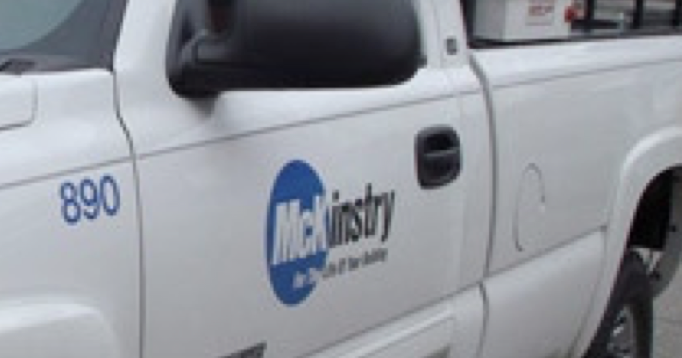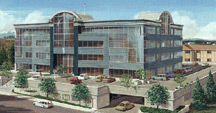From its early beginnings as a traditional plumbing contractor, McKinstry has transformed itself into an industry-leading energy and facility services company. Not only is the company ahead of a sweeping market wave, it is changing the way people think about buildings and what buildings can do.

Developing Expertise
Fifty years ago, McKinstry was a typical mechanical contractor, competing for plumbing jobs in Seattle. But to be truly successful, McKinstry's leaders knew they'd need to go beyond what customers were asking for and give them what they really need-buildings that work. Buildings that are well designed, easy to maintain, and efficient in their use of resources.
Over the years they developed capacity and expertise in all areas of design / build engineering, construction, operations and maintenance. In the process they realized that high performance is not just about installing high-efficiency equipment and state-of-the-art systems. It is about maintaining a high level of performance over time - efficient operations that drive sustainability for the life of a building.
"You just can't support your clients the way we want to support our clients if you're not focused on helping them improve their assets and their efficiency," says Ash Awad, Vice President of Energy and Facility Services. "It just becomes natural. What else would you do but offer them really keen energy and facility services?"
A New Set of Services
With a clear vision of what buildings can achieve, McKinstry developed a whole-systems strategy-from design and construction all the way through operations and maintenance.
Realizing that the value of efficient operations and maintenance is often overlooked, McKinstry has crafted its "total cost of ownership" approach to include a set of services to help their customers capture this savings and improve the value of their asset:
- Fully test the systems to make sure they are operating correctly.
- Train the facilities team so they know how to run the building to maintain performance.
- Develop and implement a comprehensive maintenance plan.
- Perform ongoing maintenance and periodic tune-ups to keep the building operating efficiently throughout its life.
In 2000 McKinstry created a team to formalize these ideas and market them directly to customers. Now called Energy and Facility Services, this team works hard to educate customers to see the big picture, to view a building as an integrated system that provides value over time. By doing so, the company is working to make energy efficiency part of the mainstream-just another part of how people do business.
To make these services cost effective, McKinstry works closely with utility companies to incorporate the incentives they offer: rebates and grants for both capital equipment and operator training. Over the years they have developed a very productive relationship with utility partners, providing feedback on their incentive programs in the marketplace, as well as generating ideas for new programs.
Identified as a forward-thinking company, McKinstry was selected to participate in the Building Performance Services Test, a pilot project designed to showcase the value of periodic tune-ups for existing buildings. The project, completed in 2005, was sponsored by BetterBricks, Puget Sound Energy, Seattle City Light and Snohomish County PUD. "The BPS Test was a significant catalyst in helping us focus on the idea of highly efficient operations," says Awad.
New Levels of Success

Sparling Technology Center in Lynnwood, WA
Although relatively new, this office building was plagued with numerous problems. Trying to maintain an even temperature, the building was being run 24/7. With a comprehensive assessment of the building, McKinstry was able to identify and repair failed compressors and fire dampers, reprogram the control system and add heat to under-served areas. Not only are the occupants more comfortable and the system easier to maintain, but the projected savings were considerable:
- Cost Savings $12,000/year
- Energy Savings 200,000 kWh/year
- 15% of total energy usage
Office Building in Bellevue, WA
This was a much larger building and also relatively new. However, to economize on the size of the mechanical room, the building was designed with small ductwork that runs high velocity air. Combined with a number of other issues, this caused the building to take in too much outside air, increasing the heating and cooling loads as well as the pressure inside the building. As a result, the front door wouldn't close properly, causing a security risk. McKinstry was able to correct the economizer operation, reduce minimum air flows, and correct the building pressure, solving several problems at once. Now, with better occupant comfort and a serious security problem eliminated, the building owners also benefit from significant energy savings:
- Cost Savings $54,000/year
- Energy Savings 1,100,000 kWh /year
- 8% of total energy usage
With each of these building tune-up projects, McKinstry also provides training for the facilities personnel. Combined with a maintenance plan and a list of "best practices" for improved operations, this training ensures the facilities team has the resources they need to maintain the performance achieved during the tune-up. McKinstry is also developing a more in-depth service offering that involves a 2-3 year ongoing relationship with facilities teams combined with annual or bi-annual check-ups.
By taking a whole-picture approach, McKinstry has not only improved its ability to create and maintain high-performance buildings, it has transformed its relationships with customers. "Now, rather than just a bidder, we're viewed as more of a partner to help our customers obtain their business objectives and goals. It's a wonderful, wonderful place to be," affirms Mike Porter, Director of Technical Services.
Such relationships require an investment of time, money and energy. But the payoff is tremendous, resulting in consulting projects, new services projects, and active energy management services.
And Yes, There are Challenges
Moving from transaction-based thinking to a total cost of ownership approach requires a cultural shift. "I think the biggest challenge that we've seen is that people have been doing things the same way for over 100 years," says Porter.
Instead of each group focusing solely on their part of the project, now everyone needs to see the whole process and how their piece fits into it. It's a huge shift in thinking. But once they do see the big picture and how the parts inter-relate, they begin to discover ways to integrate them more efficiently. The result is a building that not only performs better but does so with a smaller ecological footprint.
The process is not easy and requires someone in a leadership position on the customer side who can see the advantages and drive change within the organization.
On the other hand, in terms of marketing these ideas to prospective customers, "We've had very few challenges getting people to listen to us," says Porter. "Compared to five years ago, the challenges have decreased significantly." The market is evolving quickly and more people are willing to invest in a systematic, holistic approach to maintaining their assets.
A Promising Market
When McKinstry began offering energy services in 2000, they were ahead of the wave. A lot has happened in just a few years: the Enron crash, soaring fuel prices, awareness of global warming. As a result, there's been a sea change in the market. "People are talking about LEED. Talking about energy.
Talking about 'green.' This all helps change the mindset of organizations," says King Tang, Project Director at McKinstry. And change is taking place at all levels.
Building owners have always been interested in reducing costs. But now it's not just about dollars and cents. It's about attracting good tenants. It's about maximizing the value of the asset. It's about corporate image. It's also, subconsciously perhaps, about helping the environment.
Tenants, too, are concerned with reducing costs. But they are also concerned about sustainability. Their employees are concerned about sustainability. A good facility not only helps attract good tenants-it helps those tenants attract and retain top talent as well.
There's even been a shift in understanding what sustainability is all about. "A lot of effort has been focused on the product side of efficiency: the most efficient light bulb, the most efficient chiller. But operations has been neglected. Because you could spend a lot of money on highly efficient chillers and boilers and air handling equipment, and then not operate it properly," asserts Awad.
"Where we think the market is going and where we're focusing our attention, is in the connection between creating highly efficient, high-performance buildings and transitioning them to sustainable operations. That's the true notion of sustainability," says Awad.
With its focus on a whole-systems approach and its readiness to educate clients about the process, McKinstry is well-positioned to take full advantage of this rapidly-changing marketplace.
